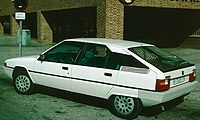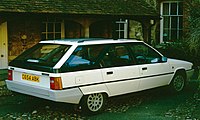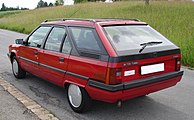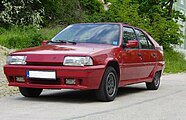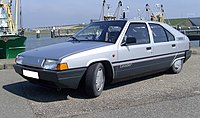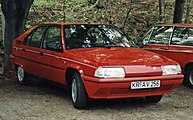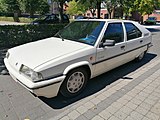Citroën BX
| Citroën | |
|---|---|
|
Citroën BX (1982-1986)
|
|
| BX (XB) | |
| Sales designation: | BX |
| Production period: | 1982-1994 |
| Class : | Compact class |
| Body versions : | Station wagon , station wagon |
| Engines: |
Otto engines : 1.1–2.1 liters (40–147 kW) Diesel engines : 1.8–1.9 liters (44–66 kW) |
| Length: | 4230-4440 mm |
| Width: | 1650-1680 mm |
| Height: | 1350-1380 mm |
| Wheelbase : | 2665 mm |
| Empty weight : | 885-1180 kg |
| Previous model | Citroën GSA |
| successor | Citroën Xantia |
The Citroën BX (factory designation XB ) is a mid-range model of the French car manufacturer Citroën built from summer 1982 to autumn 1994 in Rennes , Brittany .
Development history
Development work on the Citroën BX began in the spring of 1977; on the one hand because there was a gap between the GS and CX models , and on the other hand because of the fact that Peugeot took over Citroën on April 8, 1976.
The integration of the Citroën brand into the PSA Group heralded the beginning of the platform era. Examples of this are the LN / LNA and Visa models , based on the Peugeot 104 . The new mid-range model from Citroën should get as many parts as possible from the Peugeot shelves, primarily engines and transmissions. Nevertheless, the new model should also have the hydropneumatics typical of the brand .
Finally, the designer Marcello Gandini was commissioned to determine the appearance of the future mid-range model. His design, based on the 1979 study “Tundra” made for Volvo and the Reliant FW-11 prototype from 1977, was fine-tuned in the Citroën Vélizy design center. Production of the BX began in September 1982.
The angular body had only half as many spot welds as the previous GSA model and was developed with the help of computers ( CAD ). For weight reasons, the bonnet and tailgate were made of plastic. The consistently implemented lightweight construction concept ensured that the BX was hardly heavier and in some cases even lighter than the smaller GSA.
Despite the lack of the flowing shapes typical of Citroën, the BX was unmistakable throughout its construction period. In terms of aerodynamics , however, the BX did not quite achieve the values of the GSA. A styling element initially reserved for the top versions (16 TRS and 19 TRD) of the BX were dark-tinted polycarbonate side windows in the C-pillars. These initially had a black stripe pattern printed on the outside, which was not characterized by long durability. BX with panes painted matt black after a short period of operation were therefore often found. Peeling prints and material that quickly becomes blind due to insufficient scratch resistance led to several design changes and recalls to replace these panes. In the last model years, the windows were therefore completely omitted.
The controls were unique: a roller tachometer, often referred to by the trade press as "bathroom scales", and control satellites . A typical Citroën solution was the rev counter in the form of a vacuum fluorescent display as a green light chain, which was only found in the BX 16 TRS and BX 19 TRD models (from January 1984).
In April 1985, the introduction of the station wagon, known as Break , was the final step towards replacing the GSA, which was still being built in parallel and is now also outdated. The BX Break was developed by the French design office Heuliez and impressed with its very large loading volume, which was increased by the higher-lying roof. Its delivery began in August 1985.
Facelift
The chassis of the BX was simplified shortly after the start of series production. In the first examples, the front wishbones were still mounted in tapered roller bearings in order to be able to cope with the large chassis movements typical of hydropneumatics. These tapered roller bearings ran on rubber-mounted sleeves in order to guarantee the longitudinal elasticity for vibration isolation that is indispensable in chassis. For reasons of cost, this complex construction was replaced in 1985 by much cheaper silentblocs.
In July 1986 the BX was redesigned inside and out. From then on, the BX is referred to as "Series II".
The front turn signals became larger and were given colorless glazing, and the dashboard was completely redesigned. Roller tachometers and operating satellites gave way to normal analog instruments and conventional operating elements.
The design of the BX was further developed in the XM .
Model range
In the first few years it was still quite easy to infer the level of equipment from the type designation. Although some details were dependent on the engine installed, the basic rule was: the more letters adorned the nameplate, the higher the level of equipment.
The basic model, which was quite sparsely equipped, was offered in most markets simply with the designation BX , had a 4-speed gearbox, plastic-covered door panels and steel rims. The lack of decorative strips underlined the rather brittle charm of the entry-level version.
The station wagon called Break was not available in this configuration. The versions with two letters at the end of the type designation, for example BX 14 RE, 15 RE (Break only), 16 RS, 19 RI, 17 RD, were optically upgraded and equipped with a 5-speed gearbox, hub caps, fabric-covered door panels and radio preparation and 19 RD. This was also the most common equipment level for the Break , which - with the exception of the 1700 naturally aspirated diesel and the 16-valve engine - was offered with all engines.
The "three-letter models", such as BX 14 TRE, BX 16 TRS / TRI, BX 19 TRS / TRI and BX 19 TRD (from September 1988 onwards, these model abbreviations became 14 TGE, 15 TGE, 16 TZI) made great progress / TZS, 16 TGI, 19 TZI / TZS and 19 TZD). Central locking (partly with infrared remote control), four electric windows, rear window wipers, electric oil level control, door monitor, map reading lights, velor upholstery, power steering and much more were already part of the standard equipment.
The top of the range were the versions BX 19 GT (from 1986: GTi), BX Sport and GTi 16V, which was called GTi 16S (“Soupape”, French for valve) in France, which were offered from April 1985. The GTi models also had spoilers, fog lights, electrically adjustable exterior mirrors and oil thermometers. Later the letter abbreviations were replaced by names such as Pallas , Tecnic or Millesime .
4WD
In autumn 1989 Citroën presented the models BX 4WD Break and BX GTi 4WD with permanent all-wheel drive .
In the 4WD, the 1.9-liter petrol engine with 71-89 kW (96-121 hp) and in some markets the 1.7-liter turbodiesel with 66 kW (90 hp) did its job. It was marketed in most markets with the simpler equipment with the body of the BX Break. With a modified engine management system and 88 kW (120 PS), the 1.9-liter petrol engine was also used in the generously equipped GTi-4WD - albeit only with the sedan body.
The all-wheel drive took place via a manually lockable center differential on both axles, so it was actually " permanent " - in contrast to drive concepts with viscous coupling , in which slip must first occur on one axle before the viscous coupling becomes frictional. Vehicles equipped with ABS had a Torsen differential on the rear axle instead of a conventional differential, which automatically creates a locking effect if one of the rear wheels slips.
It is noteworthy that, despite the increased space requirement in the rear of the vehicle, neither the interior nor the trunk have been made smaller. The high price prevented greater sales of this model, although the combination of permanent all-wheel drive with a lockable center differential and, thanks to hydropneumatics, adjustable ground clearance, made the BX 4WD much more off-road than some competitor models.
The toothing of the shafts between the gearbox and the transfer case is too weak and fails after a certain mileage. The failure paralyzes the drive, spare parts are no longer available, and used parts are rare and usually also damaged. The underbody, which has been greatly modified compared to the 2WD models, made it necessary to adapt some parts, such as the exhaust system and the swing arms of the rear wheels, to the 4WD model, so that spare parts for two-wheel drive models do not fit here.
Special models
- Leader (1985): two-tone paintwork, limited number of pieces
- Digit (1985): with fully electronic digital instruments, on-board computer with 15 functions, central locking with infrared remote control (PLIP) and Pioneer car radio
- Royale (1988): metallic paintwork, aluminum rims, license plate cover, decorative stripes, edition 1750
- Chamonix (1988): special white paint, white aluminum rims, decorative stripes
- Palmares (1989): Decorative strips, rear window wipers, velvet velor fabric covers, edition of 1000
- Ruby : sliding glass roof, rear window wiper, decorative strips, cassette radio, edition 1000
- Selection : special hubcaps, rear window wipers, decorative strips, cassette radio, edition 2000
- Le Rouge (1989): GTi hub caps and velvet velor fabric covers
- Biarritz : metallic paint, GTi rear spoiler
- Liner (1989): limited edition, meteor gray metallic paint, special hubcaps, decorative stripes
- Calanque (1990): Metallic paintwork in light gray or blue, decorative stripes, checked fabric covers
- Deauville / Cannes (1990): metallic paint, decorative strips, ABS, power steering, central locking
- Image / Évasion Image (1990): Metallic paintwork in Gris-Silex, decorative stripes, black interior with red stripe pattern, chrome-plated air inlet
- Millésime (1990): metallic paintwork in gray or blue, decorative stripes, Millésime lettering
- Top (1991): metallic paintwork, GTi seats, rear spoiler, decorative stripes
- Fit (1991): GTi seats and aluminum rims, white or red paintwork
- Village (1992), paintwork in wine red or sapphire blue, decorative stripes, Village lettering, fabric covers, power steering, central locking
- LeMans (1992): metallic paintwork, GTi steering wheel, rear spoiler
In Finland a special model with an additional roof structure and missing rear seats was sold. It was very popular because it could be registered as a truck and therefore had to pay significantly lower taxes than a comparable car.
Engines
| Gasoline engine | |||||||||
|---|---|---|---|---|---|---|---|---|---|
| model | Furnishing | Cubic capacity cm³ |
Maximum power | Max. Torque | Mixture preparation | catalyst | 0-100 km / h | V max | Construction year |
| BX 11 | - | 1124 | 43 kW (58 hp) at 6250 min -1 | 79 Nm at 2750 min -1 | Carburetor | No | 17.3 s | 150 km / h | 06 / 1986-08 / 1988 |
| BX 11 | - | 1124 | 40 kW (55 hp) at 5800 min -1 | 89 Nm at 3200 min -1 | Carburetor | No | 16.3 s | 154 km / h | 09 / 1988-06 / 1991 |
| BX 14 | - | 1360 | 46 kW (62 hp) at 5500 min -1 | 108 Nm at 2500 min -1 | Carburetor | No | 14.1 s | 162 km / h | 08 / 1982-08 / 1988 |
| BX 14 | - | 1360 | 40 kW (55 hp) at 5000 min -1 | 103 Nm at 2500 min -1 | Carburetor | Yes | 18.5 s | 154 km / h | 07 / 1986-08 / 1988 |
| BX 14 | E, RE | 1360 | 53 kW (72 hp) at 5750 min -1 | 108 Nm at 3000 min -1 | Carburetor | No | 13.5 s | 163 km / h | 08 / 1982-12 / 1988 |
| BX 14 | TE, TGE | 1360 | 53 kW (72 hp) at 5600 min -1 | 111 Nm at 3400 min -1 | Carburetor | No | 14.9 s | 167 km / h | 01 / 1989-05 / 1992 |
| BX 14 | TE, TGE | 1360 | 55 kW (75 hp) at 6200 min -1 | 109 Nm at 4000 min -1 | injection | Yes | 13.3 s | 170 km / h | 01 / 1989-11 / 1994 |
| BX 15 | RE, TGE | 1580 | 59 kW (80 hp) at 5600 min -1 | 132 Nm at 2800 min -1 | Carburetor | No | 12.6 s | 170 km / h | 10 / 1986-05 / 1992 |
| BX 15 | RE | 1580 | 53 kW (72 hp) at 5600 min -1 | 111 Nm at 3400 min -1 | Carburetor | Yes | 14.1 s | 165 km / h | 09 / 1988-05 / 1990 |
| BX 16 | RS, TRS | 1580 | 66 kW (90 hp) at 6000 min -1 | 128 Nm at 3500 min -1 | Carburetor | No | 11.5 s | 176 km / h | 08 / 1982-04 / 1983 |
| BX 16 | RS, TRS | 1580 | 68 kW (92 hp) at 6000 min -1 | 131 Nm at 3500 min -1 | Carburetor | No | 11.3 s | 176 km / h | 04 / 1983–01 / 1984 |
| BX 16 | RS, TRS, TZS, TGE | 1580 | 69 kW (94 hp) at 6000 min -1 | 137 Nm at 3250 min -1 | Carburetor | No | 11.3 s | 176 km / h | 01 / 1984-05 / 1992 |
| BX 16 | RS, TRS | 1580 | 55 kW (75 hp) at 5600 min -1 | 120 Nm at 3500 min -1 | Carburetor | Yes | 14.9 s | 167 km / h | 12 / 1986-08 / 1988 |
| BX 16 | TGI | 1580 | 65 kW (88 hp) at 6000 min -1 | 128 Nm at 2700 min -1 | injection | Yes | 12.6 s | 174 km / h | 09 / 1988-11 / 1994 |
| BX 16 | TRI | 1580 | 77 kW (105 hp) at 6250 min -1 | 134 Nm at 4000 min -1 | injection | No | 11.0 s | 185 km / h | 03 / 1986-05 / 1990 |
| BX 16 | GTi | 1580 | 83 kW (113 hp) at 6250 min -1 | 131 Nm at 3000 min -1 | injection | No | 10.2 s | 194 km / h | 09 / 1988-05 / 1992 |
| BX 19 | TRS, GT | 1905 | 77 kW (105 hp) at 5600 min -1 | 162 Nm at 3000 min -1 | Carburetor | No | 10.0 s | 185 km / h | 04 / 1985-05 / 1989 |
| BX 19 | TRI | 1905 | 77 kW (105 hp) at 6000 min -1 | 141 Nm at 3000 min -1 | injection | Yes | 14.1 s | 180 km / h | 06 / 1986-05 / 1989 |
| BX 19 | TZS | 1905 | 79 kW (107 hp) at 6000 min -1 | 163 Nm at 3500 min -1 | Carburetor | No | 10.7 s | 187 km / h | 06 / 1989-05 / 1992 |
| BX 19 | TZI | 1905 | 80 kW (109 hp) at 6000 min -1 | 162 Nm at 3000 min -1 | injection | Yes | 10.9 s | 189 km / h | 04 / 1989-12 / 1993 |
| BX 19 | TZI | 1905 | 90 kW (122 hp) at 5500 min -1 | 169 Nm at 2750 min -1 | injection | No | 9.1 s | 192 km / h | 06 / 1986-05 / 1990 |
| BX 19 | TZI | 1905 | 88 kW (120 hp) at 6000 min -1 | 150 Nm at 3000 min -1 | injection | Yes | 10.9 s | 189 km / h | 05 / 1990-11 / 1994 |
| BX 19 | Sports | 1905 | 93 kW (126 hp) at 5800 min -1 | 169 Nm at 4200 min -1 | Carburetor | No | 8.9 s | 195 km / h | 04 / 1985-06 / 1986 |
| BX 19 | GTi | 1905 | 92 kW (125 hp) at 5500 min -1 | 175 Nm at 4500 min -1 | injection | No | 8.5 s | 198 km / h | 06 / 1986-05 / 1990 |
| BX 19 | GTi | 1905 | 90 kW (122 hp) at 5500 min -1 | 169 Nm at 2750 min -1 | injection | No | 9.8 s | 198 km / h | 05 / 1990-05 / 1992 |
| BX 19 | GTi | 1905 | 88 kW (120 hp) at 6000 min -1 | 150 Nm at 3000 min -1 | injection | Yes | 10.9 s | 196 km / h | 05 / 1990-12 / 1993 |
| BX 19 | GTi 16V | 1905 | 118 kW (160 hp) at 6500 min -1 | 181 Nm at 5000 min -1 | injection | No | 8.6 s | 220 km / h | 09 / 1987-05 / 1992 |
| BX 19 | GTi 16V | 1905 | 108 kW (147 hp) at 6400 min -1 | 166 Nm at 5000 min -1 | injection | Yes | 9.6 s | 215 km / h | 03 / 1988-12 / 1993 |
| BX 4TC | - | 2141 | 147 kW (200 hp) at 5250 min -1 | 294 Nm at 2750 min -1 | injection | No | 7.5 s | 220 km / h | 1985 |
| diesel | |||||||||
| model | Furnishing | Cubic capacity cm³ |
Maximum power | Max. Torque | Mixture preparation | catalyst | 0-100 km / h | V max | Construction year |
| BX 17 D | -, TD, TGD | 1769 | 44 kW (60 hp) at 4600 min -1 | 110 Nm at 2000 min -1 | Vortex chamber | No | 17.2 s | 155 km / h | 10 / 1985-05 / 1992 |
| BX 17 D Turbo | TZD | 1769 | 66 kW (90 hp) at 4300 min -1 | 180 Nm at 2000 min -1 | Vortex chamber | No | 10.8 s | 180 km / h | 09 / 1988-05 / 1992 |
| BX 17 D Turbo | TZD | 1769 | 66 kW (90 hp) at 4300 min -1 | 180 Nm at 2100 min -1 | Vortex chamber | Yes | 11.0 s | 180 km / h | 05 / 1992-11 / 1994 |
| BX 19 D | RD, TRD | 1905 | 48 kW (65 hp) at 4600 min -1 | 120 Nm at 2000 min -1 | Vortex chamber | No | 15.5 s | 157 km / h | 09 / 1983-08 / 1987 |
| BX 19 D | TD, TGD, TZD | 1905 | 52 kW (71 hp) at 4600 min -1 | 123 Nm at 2000 min -1 | Vortex chamber | No | 16.3 s | 165 km / h | 01 / 1987-05 / 1992 |
successor
The BX was replaced in two steps , similar to the previous GSA :
The presentation of the successor Xantia in November 1992 meant that the BX sedan ceased production in December 1993. The station wagon continued to roll off the production line until November 1994. In September 1995 the successor Xantia Break began .
See also
Web links
- Grandson of the goddess . In: Der Spiegel . No. 38 , 1982, pp. 258–260 ( online article on the presentation of the Citroën BX at the Paris Motor Show 1982).
- Projet XB - Citroën BX prototypes. (English) In: Citroënët. 2001.
- Citroën BX - The best modular car in the world at: garage2cv.de 2013.

